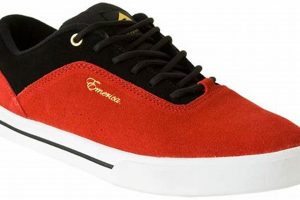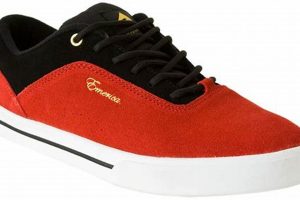Devices designed to attach to footwear, converting ordinary shoes into a form of wheeled mobility, represent a niche category within personal transportation. These items typically feature a frame that fastens to the sole of a shoe, incorporating inline wheels to simulate the experience of skating without requiring specialized skate boots. An example would be adjustable wheeled attachments secured to sneakers for recreational use.
The advantage of these shoe-mounted skating devices lies in their versatility and convenience. They offer a method for individuals to experience the thrill of skating without the bulk of traditional inline skates, allowing a quick transition between walking and gliding. Historically, concepts for attaching wheels to shoes have emerged periodically, reflecting a recurring interest in adaptable and portable personal mobility solutions. The benefits include enhanced portability and the ability to utilize existing footwear.
The subsequent sections will explore various designs, safety considerations, and potential applications of these adaptable wheeled devices. This analysis will delve into the mechanisms, materials, and user experiences associated with transforming ordinary shoes into mobile skating platforms.
Tips for Selecting Shoe-Mounted Inline Skates
The following guidelines offer considerations for individuals contemplating the acquisition and utilization of adaptable wheeled devices that attach to shoes.
Tip 1: Assess Compatibility: Confirm the devices compatibility with the user’s shoe size and style. Adjustable models may offer greater versatility across a range of footwear dimensions.
Tip 2: Evaluate Wheel Quality: Examine the wheel material and bearing quality. Polyurethane wheels generally offer superior grip and durability compared to plastic alternatives. High-quality bearings contribute to smoother rolling and reduced friction.
Tip 3: Inspect Attachment Mechanism: Scrutinize the attachment system’s robustness. Straps, buckles, or clamping mechanisms should provide a secure and stable connection between the device and the shoe.
Tip 4: Prioritize Safety Features: Seek models equipped with braking systems and reflective elements. Brakes enable controlled deceleration, while reflectors enhance visibility in low-light conditions.
Tip 5: Consider Adjustability: Opt for models that offer adjustable frame positioning and wheel alignment. This allows for customization of the skating experience and adaptation to individual preferences.
Tip 6: Read User Reviews: Consult independent product reviews to gain insights into the device’s performance, durability, and potential limitations. User feedback provides valuable information beyond manufacturer specifications.
Tip 7: Practice in a Controlled Environment: Before engaging in recreational use, practice balancing and maneuvering in a safe, open area. Familiarization with the device’s handling characteristics is crucial for preventing accidents.
Adherence to these recommendations facilitates the selection of a safe and enjoyable shoe-mounted skating experience. Careful consideration of compatibility, quality, and safety features is paramount.
The subsequent sections will explore advanced techniques and maintenance procedures associated with shoe-mounted inline devices.
1. Attachment Security
Attachment security represents a critical parameter governing the safe and effective utilization of shoe-mounted inline skating devices. The integrity of the connection between the device and the user’s footwear directly impacts stability, maneuverability, and overall user safety.
- Retention Mechanism Reliability
The reliability of straps, buckles, or clamping systems employed to secure the device to the shoe is paramount. A failure in the retention mechanism can lead to unexpected detachment during use, potentially resulting in loss of control and subsequent injury. Examples include reinforced nylon straps with locking buckles and adjustable clamp systems with secure locking mechanisms. Regular inspection and maintenance of these components are crucial.
- Surface Area Contact and Distribution
The extent of contact between the device and the shoe’s sole, as well as the even distribution of force across this area, contribute significantly to attachment security. Insufficient contact area or uneven force distribution can create stress points, leading to slippage or detachment. Designs incorporating full-sole contact plates or adjustable pressure points enhance stability and prevent premature wear. Consideration should be given to the shoe’s sole material and its compatibility with the device’s attachment system.
- Adjustability and Customization
The capacity to adjust the attachment system to accommodate various shoe sizes, shapes, and styles is essential for achieving optimal security. Generic, one-size-fits-all designs often compromise security due to variations in footwear dimensions. Adjustable straps, sliding frames, and customizable clamping configurations enable a more secure and tailored fit, minimizing the risk of slippage or detachment. The adjustability range should be clearly specified and thoroughly tested.
- Material Durability and Resistance to Environmental Factors
The materials used in the attachment system must exhibit sufficient durability and resistance to wear, tear, and environmental factors such as moisture and temperature variations. Degradation of materials can compromise the integrity of the connection over time, increasing the risk of failure. High-strength polymers, corrosion-resistant metals, and UV-resistant fabrics are often employed to ensure long-term reliability. Regular cleaning and storage in appropriate conditions can prolong the lifespan of the attachment system.
Effective attachment security fundamentally defines the practicality and safety of shoe-mounted inline devices. Designs that prioritize robust retention mechanisms, maximized surface contact, customizable adjustability, and durable materials offer the greatest assurance of a secure and reliable skating experience, thereby mitigating potential hazards associated with unexpected detachment.
2. Wheel Durometer
Wheel durometer, measured on the Shore A scale, directly influences the performance characteristics of wheeled devices attached to shoes. This measurement quantifies the hardness of the wheel material, typically polyurethane, and consequently affects grip, roll speed, and durability. A lower durometer rating indicates a softer wheel, offering enhanced grip and shock absorption but potentially sacrificing roll speed and longevity. Conversely, a higher durometer signifies a harder wheel, promoting faster rolling and increased durability at the expense of grip and comfort. Selection of an appropriate wheel durometer is therefore critical for optimizing the user experience.
For recreational use, softer wheels (e.g., 78A-82A) are often preferred, particularly on uneven surfaces, as they provide a smoother ride and better traction. Conversely, for speed skating or use on highly polished surfaces, harder wheels (e.g., 84A and above) are advantageous due to their superior rolling efficiency. The weight of the user also influences optimal durometer selection; heavier individuals may benefit from harder wheels to prevent excessive compression and maintain roll speed. A practical example involves an individual using shoe-mounted inline wheels on rough asphalt; a softer wheel would provide a more comfortable and controlled experience compared to a harder wheel, which would transmit more vibrations and potentially reduce grip.
In summary, wheel durometer is a primary determinant of performance in shoe-mounted inline applications. Careful consideration of the intended use, surface conditions, and user weight is essential for selecting the optimal durometer. The trade-off between grip, speed, and durability must be carefully evaluated to achieve a balance that maximizes user satisfaction and safety.
3. Frame Adjustability
Frame adjustability is a crucial design element in shoe-mounted inline skating devices, directly influencing user comfort, stability, and performance. These devices, intended to transform ordinary footwear into a form of wheeled transportation, necessitate a high degree of adaptability to accommodate variations in shoe size, shape, and user preference. The frame, which houses the wheels and connects to the shoe, must offer adjustment mechanisms to ensure a secure and properly aligned fit. A poorly adjusted frame can lead to instability, increased risk of falls, and inefficient energy transfer during skating. For example, a frame positioned too far forward or backward relative to the shoe’s center of gravity can create an imbalance, making it difficult to maintain control.
The importance of frame adjustability extends to accommodating diverse skating styles. Some users may prefer a more aggressive stance with a shorter wheelbase for enhanced maneuverability, while others may favor a longer wheelbase for increased stability and speed. Adjustable frames allow users to fine-tune the wheel placement to match their individual needs and skill level. Furthermore, adjustability is essential for accommodating different shoe types. The sole thickness, heel height, and overall shape of a shoe can impact the optimal frame position. Devices with limited or no adjustability may be incompatible with certain footwear, rendering them unusable or unsafe. A practical example is an adjustable frame that allows the user to center the wheels on narrow shoes, while also expanding to accommodate wider shoes for a secure fit.
In conclusion, frame adjustability is not merely a convenience feature but a fundamental requirement for shoe-mounted inline skates. It ensures compatibility across a wide range of footwear, enhances user comfort and stability, and enables customization for individual skating styles. The absence of adequate frame adjustability can compromise safety, reduce performance, and limit the overall practicality of these devices. Addressing the challenges of creating robust and user-friendly adjustment mechanisms is essential for advancing the design and adoption of shoe-mounted inline skating devices.
4. Braking mechanism
The integration of a braking mechanism is a critical safety consideration for wheeled devices designed to attach to footwear, effectively transforming shoes into inline skates. A reliable braking system enables controlled deceleration and mitigates the risk of collisions, particularly in environments with pedestrian traffic or varying terrain.
- Heel Brake Design and Implementation
The heel brake is a common braking configuration, consisting of a brake pad positioned at the rear of the frame that is activated by tilting the foot backward. Its effectiveness depends on the pad material (typically durable rubber compounds), the angle of engagement, and the user’s ability to apply consistent pressure. Heel brake systems require sufficient clearance between the wheel and the ground to function properly. A poorly designed heel brake may exhibit inconsistent stopping power or require excessive force to engage, increasing the risk of instability.
- Toe Stop Systems
While less prevalent in shoe-mounted inline designs, toe stop systems provide an alternative braking method. These systems, often found in roller skates, involve a brake pad positioned at the front of the device that is activated by extending the foot forward and applying downward pressure. Toe stop systems offer quick responsiveness and precise control, but they may require greater skill and coordination to operate effectively. Their suitability for shoe-mounted inline applications is contingent on the overall design and the user’s skating proficiency.
- Brake Pad Material and Wear Resistance
The selection of brake pad material significantly impacts braking performance and longevity. Rubber compounds with high coefficients of friction provide superior stopping power, while abrasion-resistant formulations extend the lifespan of the brake pad. The rate of wear depends on factors such as usage frequency, surface conditions, and user weight. Regular inspection and replacement of worn brake pads are essential for maintaining optimal braking performance.
- Mechanical Linkage and Activation Force
The mechanical linkage connecting the brake pad to the activation point (e.g., the heel or toe) must be robust and responsive. Excessive play or friction in the linkage can reduce braking efficiency and increase the force required to engage the brake. The activation force should be ergonomically optimized to minimize user fatigue and maximize control. Linkage designs incorporating adjustable tension or leverage ratios allow for customization to individual preferences.
The effectiveness and reliability of the braking mechanism directly influence the safety and practicality of shoe-mounted inline skates. Designs that prioritize responsive braking systems, durable components, and user-friendly activation mechanisms offer the greatest assurance of controlled deceleration and reduced risk of accidents. Continued innovation in braking technology is essential for advancing the safety and usability of these devices.
5. Shoe compatibility
Shoe compatibility represents a critical factor in the design and usability of inline skating devices intended for attachment to footwear. The successful integration of these devices hinges on their ability to securely and effectively interface with a diverse range of shoe styles and sizes. Failure to achieve adequate shoe compatibility can compromise safety, performance, and overall user satisfaction.
- Sole Profile and Attachment Interface
The profile and geometry of the shoe’s sole dictate the type of attachment mechanism required for a secure connection. Flat-soled shoes may accommodate direct clamping systems, while contoured soles necessitate adjustable or conforming interfaces. Incompatibility between the sole profile and the attachment interface can lead to slippage, instability, or even damage to the shoe. Examples include adjustable strap systems designed to accommodate varying sole thicknesses and contoured baseplates that conform to the arch of the foot. The attachment interface must distribute pressure evenly to prevent localized stress points.
- Size Adjustment Range and Shoe Size Variability
Inline skating devices intended for shoe mounting must offer a sufficient size adjustment range to accommodate a wide spectrum of shoe sizes. Standardized shoe size conventions vary across regions, necessitating a flexible sizing system. Inadequate size adjustment can result in either an excessively loose or overly tight fit, both of which compromise stability and comfort. Adjustable frame lengths, sliding clamp mechanisms, and interchangeable components are employed to enhance size versatility. Clear and accurate sizing guidelines are essential for ensuring proper fit.
- Material Compatibility and Durability
The materials used in the construction of shoe-mounted inline skating devices must be compatible with the materials commonly found in footwear, such as leather, synthetic fabrics, and rubber. Incompatible materials can lead to degradation, discoloration, or adhesive failure. The attachment mechanism must also be durable enough to withstand the stresses and strains associated with skating without damaging the shoe. Reinforced polymers, corrosion-resistant metals, and abrasion-resistant fabrics are frequently used to ensure durability and compatibility. Proper cleaning and maintenance procedures can extend the lifespan of both the device and the footwear.
- Weight Distribution and Stability Considerations
The weight distribution of the inline skating device, when attached to the shoe, significantly impacts stability and maneuverability. An improperly balanced device can create an uneven load on the foot, leading to fatigue or discomfort. The frame design should distribute weight evenly across the sole to maintain a stable platform. Factors such as wheel placement, frame material, and attachment point locations contribute to overall weight distribution. Testing and refinement of the design are essential to optimize stability and minimize the risk of imbalance.
The successful integration of shoe-mounted inline skating devices is contingent upon addressing the multifaceted aspects of shoe compatibility. By considering sole profile, size adjustment, material compatibility, and weight distribution, manufacturers can create devices that offer a safe, comfortable, and enjoyable skating experience across a diverse range of footwear options.
6. Bearing quality
Bearing quality directly influences the performance and longevity of inline skates adapted for use with shoes. These small, circular components, typically located within the wheels, facilitate smooth rotation and reduce friction. Lower-quality bearings impede wheel spin, resulting in reduced speed, increased effort, and premature wear. Conversely, high-quality bearings allow for efficient energy transfer, enabling faster speeds, smoother rides, and extended component lifespan. As the user is relying on their own shoes, which are not specifically designed for skating, any increase in friction or instability caused by low-quality bearings can exacerbate balance challenges and potentially increase the risk of falls. An example is a user navigating a slight incline; skates with substandard bearings require significantly more exertion than those equipped with precision bearings.
The quality of bearings in these shoe-adapted skates impacts several practical considerations. For instance, bearings constructed from hardened steel or ceramic materials exhibit greater durability and resistance to corrosion compared to bearings made from softer metals. Precision-engineered bearings with tight tolerances minimize vibration and noise, contributing to a more comfortable skating experience. Furthermore, properly sealed bearings prevent the ingress of dirt and debris, maintaining consistent performance and reducing the need for frequent maintenance. The cost of upgrading to higher-quality bearings can often be justified by the improved performance, extended lifespan, and enhanced safety they provide. A real-world application involves fitness enthusiasts who prefer using adaptable wheel devices for exercising in urban environments; superior bearings enable longer, more efficient workouts with reduced joint stress.
In summary, bearing quality constitutes a crucial element in determining the overall effectiveness and safety of inline skates for shoes. Opting for high-quality bearings translates to enhanced performance, increased durability, and a more enjoyable skating experience. While the initial investment may be higher, the long-term benefits, including reduced maintenance costs and improved user safety, outweigh the incremental expense. Choosing quality bearings ultimately contributes to a safer and more efficient mode of personal mobility. Challenges remain in educating consumers regarding bearing specifications and performance metrics, necessitating clearer labeling and standardized testing procedures.
7. Portability
Portability constitutes a primary advantage of shoe-mounted inline skating devices, distinguishing them from traditional inline skates. The ability to easily transport and transition between walking and skating modes enhances the practicality and convenience of this form of personal mobility.
- Compact Design and Storage
The reduced size and weight of shoe-mounted inline skates facilitate compact storage in backpacks, bags, or lockers. Traditional inline skates, due to their integrated boot design, occupy significantly more space and require dedicated carrying cases. Adaptable wheeled devices, conversely, can be quickly detached from footwear and stowed in a compact manner, making them ideal for commuters or individuals with limited storage space. For example, a student commuting to campus could easily carry these devices in their backpack and transition to skating upon arrival, conserving time and energy.
- Quick Transition Capability
The ability to rapidly switch between walking and skating modes is a key attribute of portable shoe-mounted skates. Traditional inline skates necessitate the use of specialized footwear and a separate carrying method when not in use. Shoe-mounted devices, however, allow the user to seamlessly transition between activities without the need to change shoes or carry bulky equipment. For example, a tourist exploring a city could quickly switch from walking to skating to cover greater distances and then revert to walking when navigating crowded areas or entering buildings.
- Lightweight Construction and Reduced Burden
The materials used in the construction of shoe-mounted inline skates, such as lightweight polymers and aluminum alloys, contribute to their overall portability. Traditional inline skates, with their rigid boot structures, tend to be heavier and more cumbersome to carry. The reduced weight of shoe-mounted devices minimizes the burden on the user during transport, making them a more practical option for everyday use. An example is a messenger who needs to traverse urban environments efficiently; the lightweight nature of these devices allows for extended periods of use without excessive fatigue.
- Integration with Existing Footwear
The inherent design of shoe-mounted inline skates leverages the user’s existing footwear, eliminating the need to carry separate skating boots. This integration simplifies the overall transportation process and reduces the number of items the user must manage. Traditional inline skates require the user to carry both their skating boots and a separate pair of walking shoes. Shoe-mounted devices streamline this process by allowing the user to utilize their everyday footwear for both activities. An instance could be a traveler navigating an airport; the traveler can transition between walking and skating as needed without the burden of carrying extra shoes.
These facets highlight the practical advantages of shoe-mounted inline skates in terms of portability, illustrating how their design and functionality address the limitations associated with traditional inline skates. The ability to easily store, quickly transition, and seamlessly integrate with existing footwear enhances the user experience and promotes the adoption of these devices as a viable mode of personal transportation.
Frequently Asked Questions
The following questions address common concerns and misconceptions regarding the use and functionality of adaptable wheeled devices designed to attach to shoes, often referred to as shoe-mounted inline skates.
Question 1: Are shoe-mounted inline skates safe for everyday use?
The safety of these devices depends largely on user skill, adherence to safety precautions, and the quality of the product. It is imperative to wear appropriate protective gear, such as helmets and pads. Additionally, users should familiarize themselves with the device in a controlled environment before attempting to navigate public spaces.
Question 2: What types of shoes are compatible with shoe-mounted inline skates?
Compatibility varies by product. Generally, shoes with relatively flat, rigid soles offer the most stable platform. Avoid footwear with excessively thick or soft soles, as these can compromise stability and control. Consult the manufacturer’s specifications for specific shoe type recommendations.
Question 3: How do shoe-mounted inline skates compare to traditional inline skates in terms of performance?
Traditional inline skates, with their integrated boot design, generally offer superior ankle support and control. Shoe-mounted alternatives may exhibit limitations in these areas. However, they provide enhanced portability and the convenience of using existing footwear.
Question 4: What is the expected lifespan of shoe-mounted inline skates?
The lifespan depends on factors such as usage frequency, terrain, and maintenance. Regular inspection and replacement of worn components, such as wheels and bearings, can extend the product’s lifespan. Adherence to the manufacturer’s maintenance guidelines is recommended.
Question 5: Are shoe-mounted inline skates suitable for all skill levels?
These devices may present a greater challenge for beginners due to the lack of integrated ankle support found in traditional inline skates. Individuals with prior skating experience may adapt more readily. Beginners should consider starting with traditional inline skates to develop fundamental skills.
Question 6: Where can one purchase shoe-mounted inline skates?
These devices are typically available through online retailers, sporting goods stores, and specialty skate shops. It is advisable to purchase from reputable vendors and carefully review product specifications and user reviews before making a purchase.
In summary, shoe-mounted inline skates offer a unique approach to personal mobility, but their safety and performance depend on various factors. Careful consideration of user skill, product quality, and adherence to safety precautions is paramount.
The subsequent section will provide resources for further research and information on shoe-mounted inline skating devices.
Conclusion
This exposition has dissected “inline skates for shoes,” scrutinizing their functionality, safety considerations, and potential applications. The analysis encompasses attachment security, wheel durometer, frame adjustability, braking mechanisms, shoe compatibility, bearing quality, and portability. Each element significantly impacts the device’s overall performance and suitability for diverse users and environments.
The integration of such devices into daily life necessitates responsible design, diligent manufacturing, and conscientious usage. Further research into material science, ergonomic design, and safety protocols is crucial to optimize these mobility solutions. Continued development should prioritize user safety and long-term sustainability.



![Find Your Fit: Most Comfy Skate Shoes Reviewed [Guide] Safem Fabrication - Precision Engineering & Custom Manufacturing Solutions Find Your Fit: Most Comfy Skate Shoes Reviewed [Guide] | Safem Fabrication - Precision Engineering & Custom Manufacturing Solutions](https://cruzskateshop.com/wp-content/uploads/2025/06/th-3365-300x200.jpg)
![Best Inline Skate Shoes of [YEAR]: Reviews & Guide Safem Fabrication - Precision Engineering & Custom Manufacturing Solutions Best Inline Skate Shoes of [YEAR]: Reviews & Guide | Safem Fabrication - Precision Engineering & Custom Manufacturing Solutions](https://cruzskateshop.com/wp-content/uploads/2025/06/th-3318-300x200.jpg)


